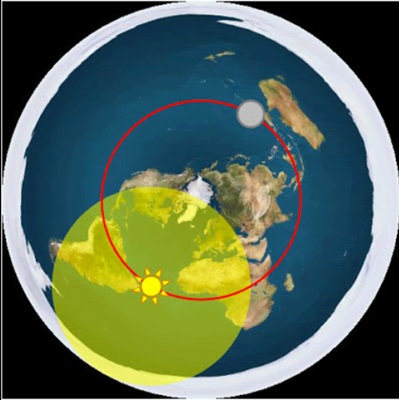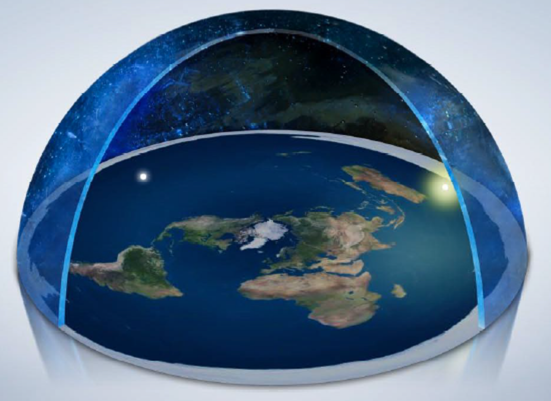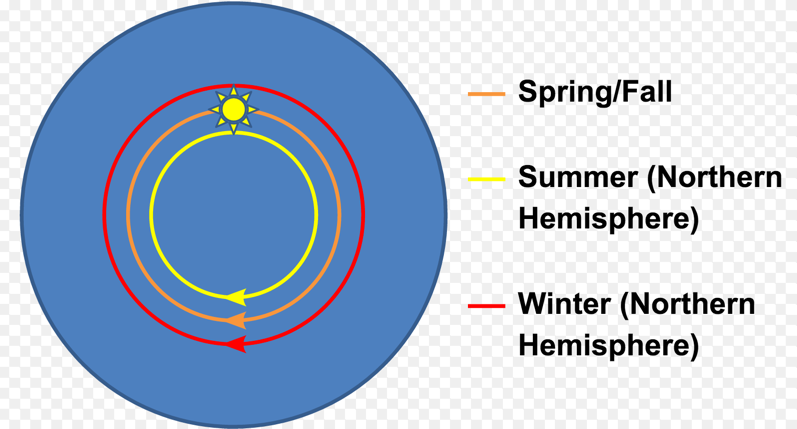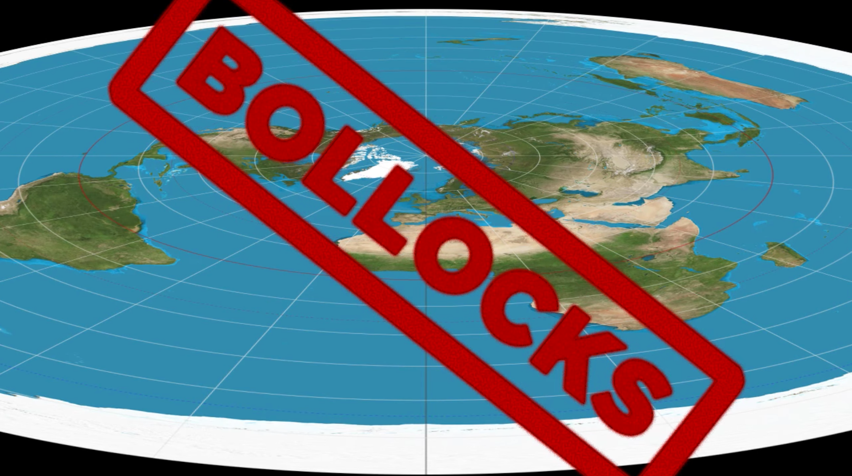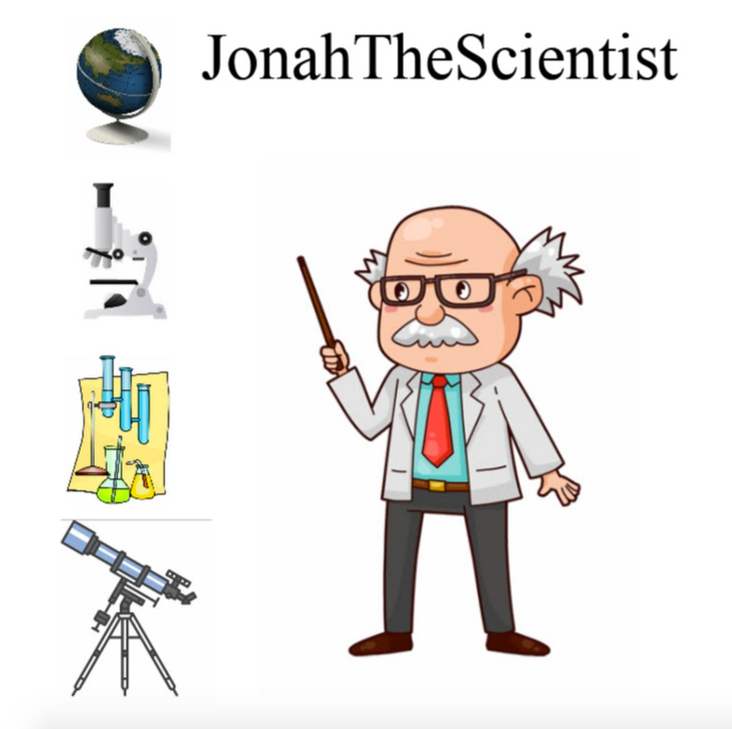Mr. Mark Sargent, the Earth is not stationary. Try this easy junior high school experiment yourself to find out the reality.
- - -
NOTICE of April 27th: Mark has already deleted our invitation to do this experiment. By deleting this comment, Mark is also now complicit in hiding reality from his YouTube audience.

- - -
Dear Mr. Sargent,
An easy experiment for any young adult (14+) to prove that the Earth moves and is orbiting the Sun.
Mark, before you say that the planet Jupiter is a light in the sky and there is nothing there to land on, think again. A small telescope reveals that Jupiter is large, round and rotates. Satellites revolve around it. Why do you adhere to the same denial as the clergy who sentenced Galileo to death? You are lost and live in your own world of make believe, afraid to accept reality.
All you need is:
A small telescope (3-inches or larger)
A stop watch
Ephemeris listing of Jupiter moon eclipse times
Math skills such as adding, subtracting, dividing and multiplying
The ability to read and understand what you read
The experiment:
The four major moons of Jupiter are easily seen with a 3-inch telescope. They look like bright stars.
Consult the Ephemeris for the time that a moon will be eclipsed (enter the shadow of Jupiter and disappears from your telescope view).
20 minutes before the eclipse take your telescope outside and point a Jupiter. Focus the eyepiece to see Jupiter and the moon(s). Since the four moons of Jupiter are always in rotational orbit around the planet, at any given time you may see one or several.
Watch the eclipse and determine the time the moon disappeared from view as it enters Jupiter's shadow (you no longer see it). Start your stopwatch when the moon disappears and then reference that to Coordinated Universal Time site to get the actual Universal Time of the eclipse event.
Record the time and date of each event in a notebook.
Continue for 6-month to observe as many eclipses as weather permits. Best to start your experiment on a date that the Earth is closest to Jupiter, and end the experiment on a date when the Earth is farthest from Jupiter. Consult the Ephemeris listed below.
How does this work?
Referring to the photo below, determine the eclipse time at distance (a). Calculate when you should see the next eclipse at distance (b). You will find that the eclipse at distance (b) occurs minutes later than the predicted time. That is because light now has to travel a further distance to get to the Earth, (b) - (a) = x miles further away.
Since distance = velocity * time, we can also write this as ...
distance change between the earth and Jupiter = speed of light * time [between calculated and observed eclipse at point (b).]
Since you actually observed the eclipse to occur later than predicted, that proves the Earth moved between the time of eclipse (a) and eclipse (b). YES. You have now proved earth movement around the Sun.
This is a reproduction of the Ole Roemer experiment conducted in 1676, the first successful determination of the speed of light. Galileo tried in 1638 using lanterns on two different mountain peaks, but did not get a number. However, Galileo did conclude that the speed of light was at least several times faster than the speed of sound.
Do this experiment for each of the four large moons of Jupiter.
"I did this experiment myself in 1971 - 1972 and got accurate results," JonahTheScientist
- - -
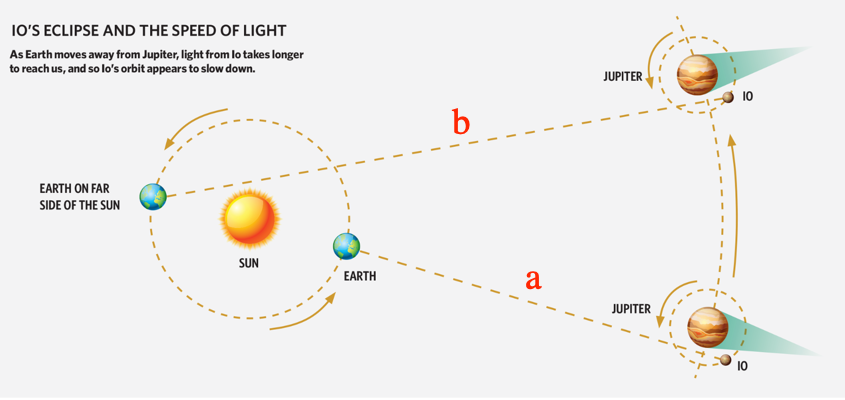
- - - - - - - - - - - - - - - - - - - - - - - - - - - - - - - - - - - - - - - - - - - - - - - - - - - - - - - - - - - - - - - - - - - - - - - - - - - - - - - - - - - - - - - -
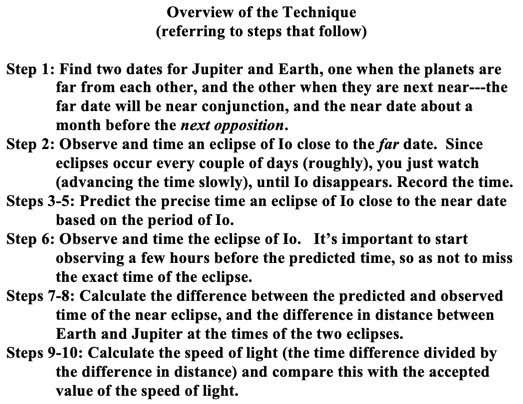
After all observations are done, it's time to analyze the data and come up with the results.
1. Find two dates when Jupiter and earth are far and near, preferably about two to three months after Jupiter is in conjunction and about a month before Jupiter is at opposition These conditions ensure that Jupiter’s shadow is to the east of the planet so that eclipses are easily seen.
The Far Date and Near Date for this example are:
Near Date = May 10, 2019 (about a month before opposition)
Far Date = March 12, 2020 (about 2.5 months after conjunction)
| 10 Jun 2019 | – Jupiter at opposition |
| 14 Jul 2020 | – Jupiter at opposition |
| 19 Aug 2021 | – Jupiter at opposition |
| 26 Sep 2022 | – Jupiter at opposition |
- - - - - - - - - - - - - - - - - - - - - - - - - - - - - - - - - - - - - - - - - - - - - - - - - - - - - - - - - - - - - - - - - - - - - - - - - - - - - - - -
2. Observe and time an eclipse of Io on the Far Date
(the eclipse happens at the moment Io moves into Jupiter’s shadow). If there is no eclipse on your Far Date, there will be one the next day – observe that one.)
OBSERVING TIPS:
- Set the magnification view to 400x and use the ID Colors to identify Io.
- Turn on the “Top View” to see where Io is with respect to the position of Jupiter’s shadow.
- When Io is more than one Jupiter disk away from the planet’s edge, set the Observing Interval to 0.5 hour.
- Use the Next button to advance the observations.
- When Io is one Jupiter disk away from the planet’s edge, set the Observing Interval to 0.01 hour. Advance a few steps…
- When Io is about one quarter of a Jupiter disk away from the planet’s edge, set the observing interval to 0.005 hours.
- Gradually advance time, step by step, until the moon just disappears---this is the start of the eclipse.
Time of the Far Date Eclipse
Standard Format: March 1, 2008 18h 07m 18 sec
Julian Day: 2454527.255069
- - - - - - - - - - - - - - - - - - - - - - - - - - - - - - - - - - - - - - - - - - - - - - - - - - - - - - - - - - - - - - - - - - - - - - - - - - - - - - - -
3. Estimate how many orbits Io will make from the Far Date to the Near Date
Number of Orbits = (Far Date – Near Date) / Synodic Period of Io
Synodic Period of Io = 1.769861 days
Number of Orbits = (May 31, 2008 – March 1, 2008) / 1.769861 days per orbit
Number of Orbits = 91 days / 1.769861days per orbit = 51.42 orbits
Round the value down to a whole number of orbits:
Number of Orbits = 51
Note: This is the number of orbits Io will make to go from the first eclipse on the Far Date to the predicted eclipse at the Near Date
- - - - - - - - - - - - - - - - - - - - - - - - - - - - - - - - - - - - - - - - - - - - - - - - - - - - - - - - - - - - - - - - - - - - - - - - - - - - - - - -
4. Calculate the time interval from the first eclipse to the predicted eclipse
Time to Predicted Eclipse = Number of Orbits x Synodic Period of Io (don’t round off the period—keep as many decimal places as you can)
Time to Predicted Eclipse = 51 orbits x 1.769861 days per orbit
= 90.262904 days
- - - - - - - - - - - - - - - - - - - - - - - - - - - - - - - - - - - - - - - - - - - - - - - - - - - - - - - - - - - - - - - - - - - - - - - - - - - - - - - -
5. Calculate the JD of the predicted eclipse at the Near Date:
Predicted Eclipse Time = Far Eclipse Time (JD) + Time to Predicted Eclipse
Predicted Eclipse Time = 2454527.255069 + 90.262904
= 2454617.517973
- - - - - - - - - - - - - - - - - - - - - - - - - - - - - - - - - - - - - - - - - - - - - - - - - - - - - - - - - - - - - - - - - - - - - - - - - - - - - - - -
6. Observe the predicted eclipse
Advance the simulation to a few hours before the Near Date eclipse. Starting your observations before the predicted eclipse is a key part of getting good data. The reason for this is that you expect the near eclipse to occur several minutes before the predicted time, and you don’t want to miss it. If you miss it, and observe the next eclipse, several days later, you won’t get the right speed of light. So, just to be on the safe side, let’s start our observations 0.1 JD, or 2.4 hours, before the predicted eclipse time. In other words, since the predicted eclipse time is Julian Day 2454617.517973, we start our observations on Julian Day2454617.417973. Then slowly advance the time to catch the predicted eclipse a few minutes before your predicted time.
Observe and time the eclipse of Io that happens on this Near Date
Observed Eclipse Time (JD) = 2454617.508208
- - - - - - - - - - - - - - - - - - - - - - - - - - - - - - - - - - - - - - - - - - - - - - - - - - - - - - - - - - - - - - - - - - - - - - - - - - - - - - - -
7. Find the time difference between the predicted eclipse and the observed eclipse
Time Difference = Observed Eclipse Time (JD) – Predicted Eclipse Time (JD)
Time Difference = 2454617.508208 – 2454617.517973
= – 0.009765 days
Time Difference (ΔT) = – 14.1 minutes
Note: The negative value indicates the eclipse occured before the predicted time.
- - - - - - - - - - - - - - - - - - - - - - - - - - - - - - - - - - - - - - - - - - - - - - - - - - - - - - - - - - - - - - - - - - - - - - - - - - - - - - - -
8. Find the change in distance between Jupiter and earth from the Far Date to the Near Date
Distance (au) of Jupiter from Sun (March 1) = 5.71785 au
Distance (au) of Jupiter from Sun (May 31) = 4.39149 au
Change in distance = March 1 distance – May 31 distance
Change in Distance (ΔD) = 5.71785 au – 4.39149 au
= 1.32636 au
- - - - - - - - - - - - - - - - - - - - - - - - - - - - - - - - - - - - - - - - - - - - - - - - - - - - - - - - - - - - - - - - - - - - - - - - - - - - - - - -
9. Calculate the Speed of Light
Speed of Light = ΔD / ΔT
Speed of Light = 1.32636 au / 14.1 minutes
= 0.094327 au / minute
Convert this value in au / minute to the more familiar meters / second
Speed of Light = 2.34 x 108 m/s
- - - - - - - - - - - - - - - - - - - - - - - - - - - - - - - - - - - - - - - - - - - - - - - - - - - - - - - - - - - - - - - - - - - - - - - - - - - - - - - -
10. Compare your value to c
Find the Percent Difference between your calculated value of the Speed of Light and the accepted value, c = 3.00 x 108 m/s
Percent Difference = [ (Speed of Light – c) / c ] x 100%
Percent Difference = [ (2.34 x 108 m/s – 3.00 x 108 m/s) / 3.00 x 108 m/s ] x 100%
= [ – 0.64 x 108 m/s / 3.00 x 108 m/s ] x 100%
= – 21%
- - - - - - - - - - - - - - - - - - - - - - - - - - - - - - - - - - - - - - - - - - - - - - - - - - - - - - - - - - - - - - - - - - - - - - - - - - - - - - - -
Reference:
Jupiters Moons and the Speed of Light. Get here the "Student manual For the Roemer experiment (MS Word format)
http://www3.gettysburg.edu/~marschal/clea/roemerlab.html
- - -
The following chart shows the position of the large 4 moons of Jupiter (Io, Europa, Ganymede and Callisto) with respect to the planet itself when you look at it through your telescope.
Before you go outside to observe Jupiter, consult this chart. Set the date for today.
(https://in-the-sky.org/jupiter.php)
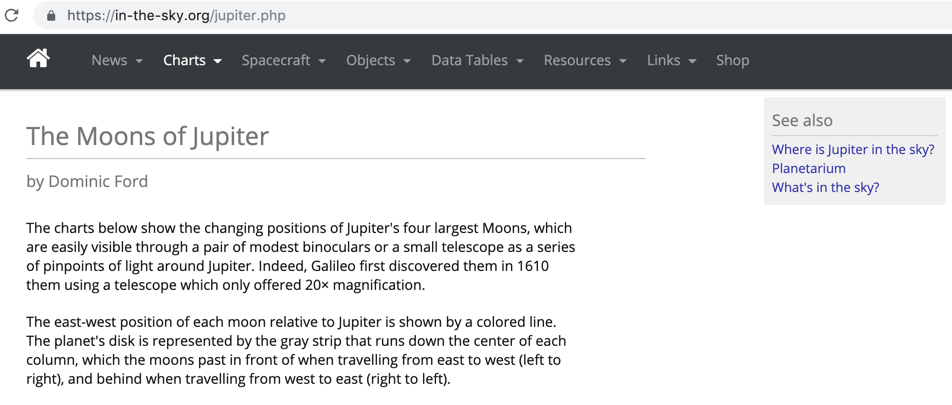
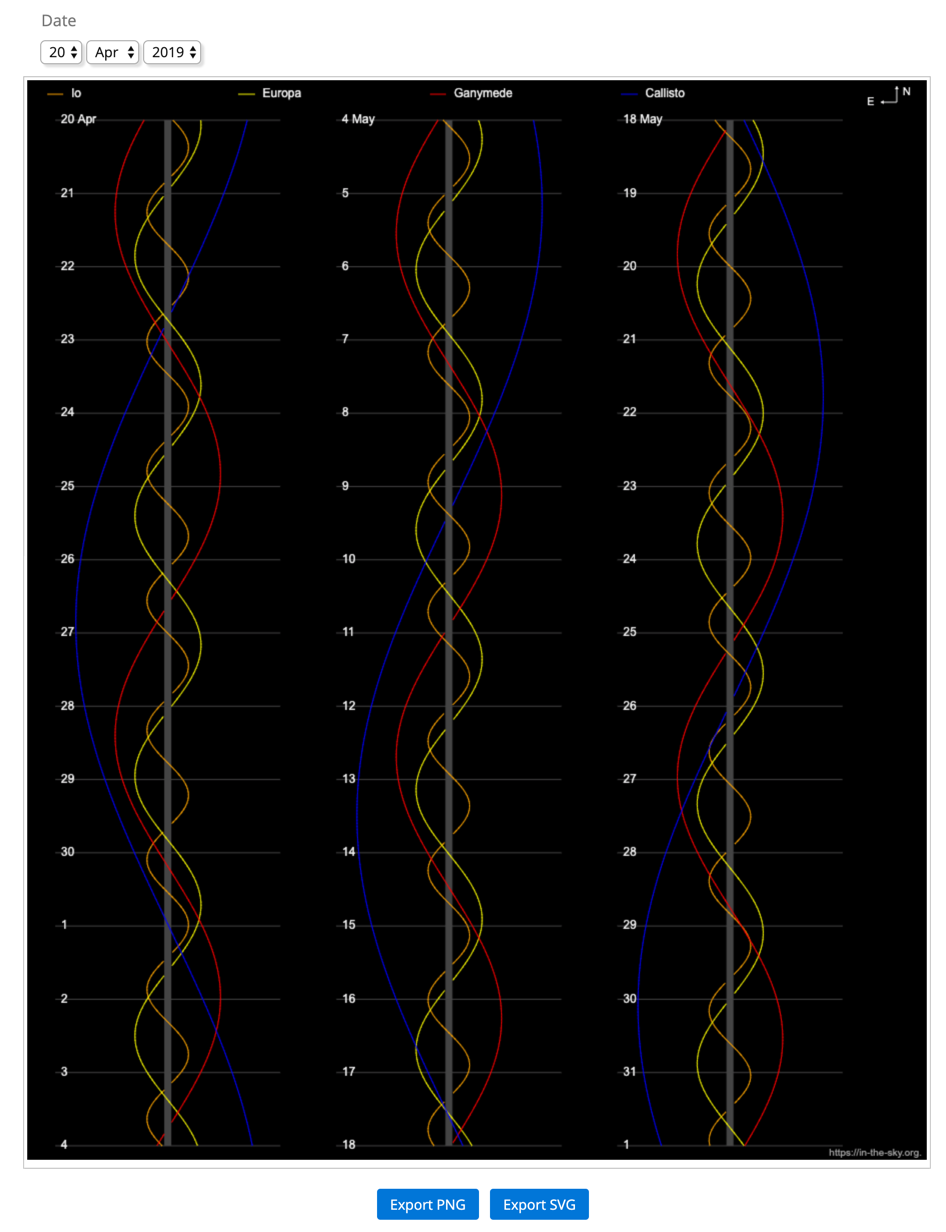
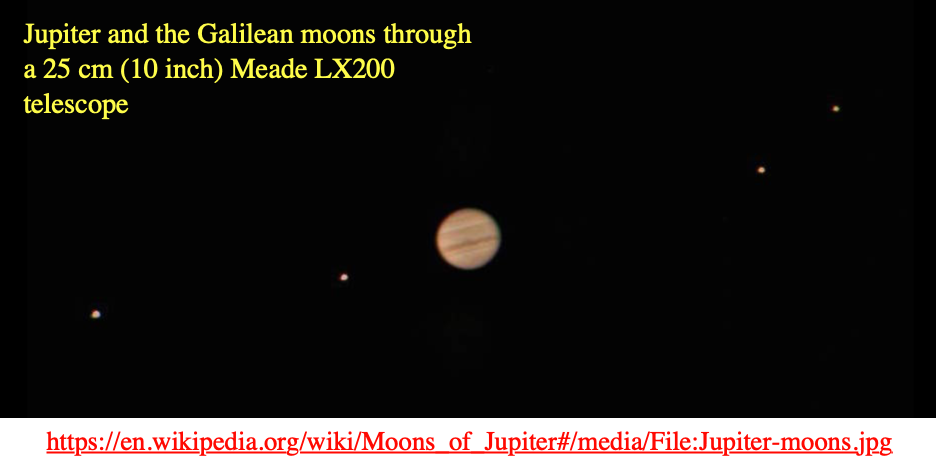
- - -
Coordinated Universal Time
https://time.is/UTC
Geocentric Ephemeris for Jupiter : 2019
http://astropixels.com/ephemeris/planets/jupiter2019.html
https://s22380.pcdn.co/wp-content/uploads/WebJphenTab2019.pdf
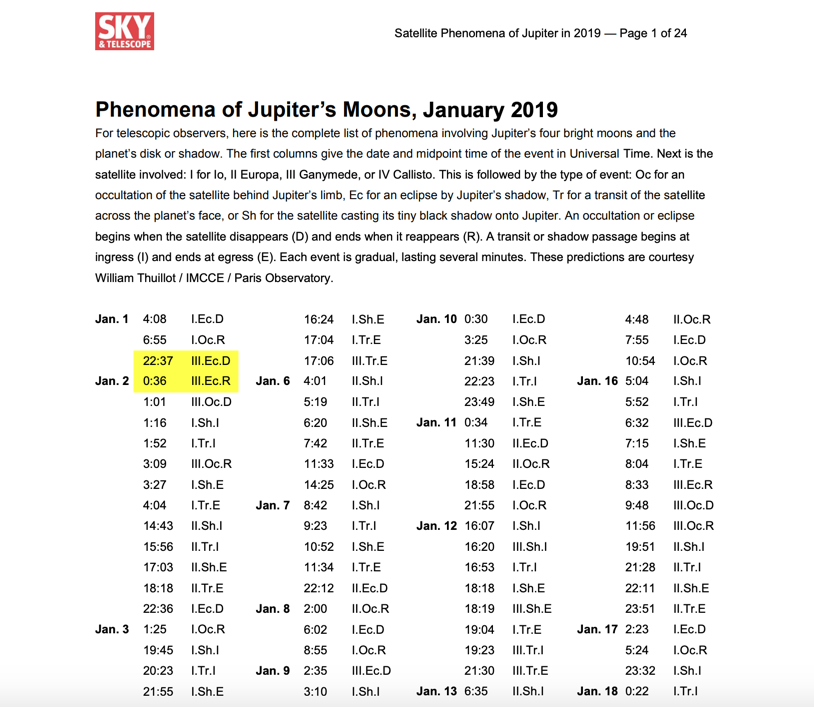
- - -
Published on – April 24, 2019
Discussion at - https://www.youtube.com/channel/UC7ipUKERU0tzYFxALJBli4A/discussion
Our home page all articles - http://flatearthlunacy.com
kind regards, JonahTheScientist



